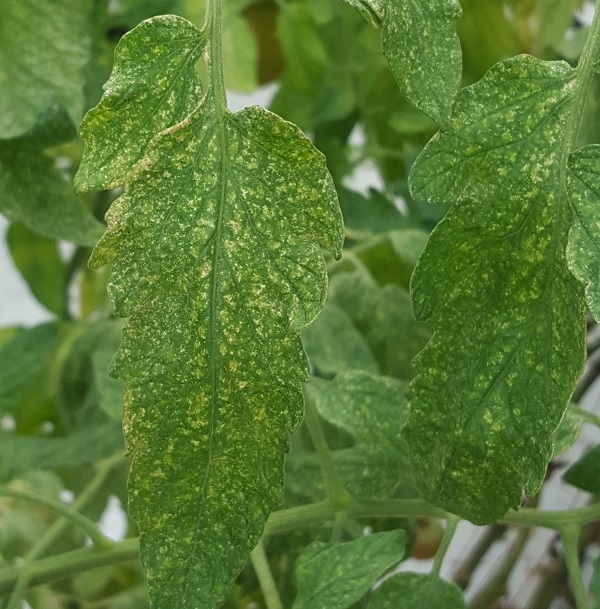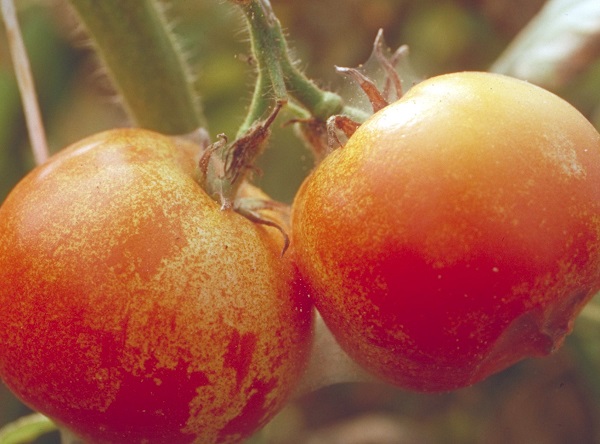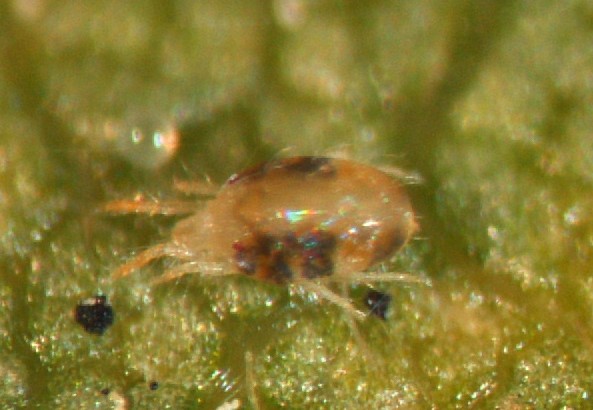Two-Spotted Spider Mite
ENTFACT-310: Two-Spotted Spider Mite | Download PDF
Ric Bessin, Extension Specialist
University of Kentucky College of Agriculture
Two‑spotted spider mites are occasional pests that can cause serious damage to some vegetable crops during hot dry weather. Mites can injure tomatoes, beans, muskmelons, watermelons, and sweet corn. Extended periods of hot, dry weather favors mite buildups. Infestations usually first occur at the edge of a field, typically near rank weed growth or dirt roads.

Figure 1. Spider mite feeding causes a mottled color pattern to leaves called stippling.
Generally, mites feed on the undersides of leaves. They use their sucking mouthparts to remove sap from plants, giving the upper leaf surface a speckled or mottled appearance. Leaves of mite-infested plants may turn yellow and dry up, and plants may lose vigor and die when infestations are severe. The undersides of affected leaves appear tan or yellow and have a crusty texture. Heavy infestations of the two‑spotted spider mite produce fine webbing that may cover the entire plant. Mites are identified by shaking symptomatic leaves onto a sheet of white paper or by observing infected leaf areas with a hand lens. In hot dry weather, mites can cause plants to drop leaves in a few weeks. Fruit from severely infested plants are often unmarketable because defoliated plants tend to yield small, poor quality fruit.

Figure 2. Heavy mite damage is accompanied by webbing.
Biology
The eight‑legged female mites are yellow to dark green with two to four dark dorsal spots. At 1/60 of an inch, they are almost microscopic. Males are smaller with more pointed abdomens. The tiny, spherical, eggs are laid on the undersides of leaves, often under the webbing produced by the mites. A six‑legged, colorless larva that emerges resembles the nymph and adult, but is only the size of an egg. Both of the eight‑legged nymphal stages look like the adult, but are smaller and not sexually mature. Under optimum conditions of high temperature and low humidity, the life cycle may be completed in 7 days. Females can lay 200 eggs.
Two Spotted Spider Mite Management
Natural enemies of mites are present in and around fields and can keep mite populations low. Many insecticides used for control of insect pests severely reduce numbers of beneficial insects that keep mite populations in check. Therefore, apply insecticides only as‑needed, rather than at regularly scheduled intervals. When possible, select pesticides which will have the least impact on beneficial insects.

Figure 3. Two-spotted spider mite usually have two dark spots, but some may be red in color.
Destruction of weeds adjacent to and in fields is done in the fall or early spring. Growers should manage weeds around fields carefully during the season. Grass must be mowed regularly. Spraying or mowing of weeds after growth has become rank may increase the movement of mites to cultivated plants.
Use of overhead‑sprinkler irrigation may provide some short‑term relief of mite infestations.
Miticides are available for some vegetable crops but should be used only where justified. As with aphids, mark infestations with flags, and check them again every 3 or 4 days. Mites can easily be moved to infested plants on clothing, so always examine infested areas last during inspections. If the infestation is not spreading, treatment will not be required. Because mite populations often are localized, spot spraying may be effective. If you spray only a portion of the field, spray a buffer zone of 100 to 200 feet beyond the mite infested area.
Resistance to pesticides has increased the difficulty of controlling these pests. Because mites usually occur on the undersides of leaves, applications of contact miticides need to be directed at both the lower and upper leaf surfaces. Mite eggs are resistant to most miticides, so repeated applications are often necessary to control infestations. Two applications spaced 5 to 7 days apart may be necessary.
Revised: 11/19
CAUTION! Pesticide recommendations in this publication are registered for use in Kentucky, USA ONLY! The use of some products may not be legal in your state or country. Please check with your local county agent or regulatory official before using any pesticide mentioned in this publication.
Of course, ALWAYS READ AND FOLLOW LABEL DIRECTIONS FOR SAFE USE OF ANY PESTICIDE!
Photos courtesy Ric Bessin, University of Kentucky Entomology
